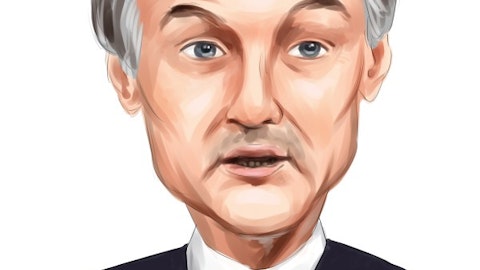So that’s kind of the view on the market. What are we doing to – again, I don’t think we have undue reliance on hardware services or software. We have a solution set that basically gets bought in conjunction by customers. So no customer wants an ATM – or they want an ATM, they want the service associated with that, they want the software associated with that. So clearly, as we package these components together, we will allow customers to either buy the components individually, buy them in a predefined solution for them or buy them as a service. We keep growing as well in our managed services business, allowing customers to outsource important parts of their operation to us. So as we provide customers this flexibility of choice, we see that some of them might opt to move to more of an outsourced model, while others will – might remain committed to them running their own operations as they drive significant value from our technology.
So I would say that we’re optimistic that we will have for that by providing customer choice, we can continue driving growth in our business.
Matt Summerville: Thanks, Octavio.
Operator: Thank you. [Operator Instructions] Our next question comes from Matt Bryson of Wedbush Securities. Matt, your line is now open. Please go ahead.
Matt Bryson: Thanks for letting me ask question. The 40%, 60% split in terms of free cash flow, any chance you can give us kind of a similar split or a way to think about how revenues might progress through 2024.
Jim Barna: Yes. Thanks, Matt. What I would say is that the relative split on that on revenue is going to roughly align. I think that as we think about that cadence, right, that they’re roughly going to fall in line with each other. So I wouldn’t expect for there to be a material deviation in terms of how we think about revenue and then it’s kind of its flow through to EBITDA and then to free cash flow. So again, not precise numbers, right, given the fact that we’re not giving quarterly guidance, but I would think about those as being fairly well correlated.
Matt Bryson: Got it. And if revenues don’t dip so much or product shipments don’t dip so much, can we expect that the benefit on the gross margin line from having higher volumes continues kind of throughout the course of 2024? Or is there something of a dip in the first half as revenues are a little bit higher or a little bit lower and then it picks back up in the back half?
Jim Barna: Are you talking about product gross margins, just to make sure that I understand the question?
Matt Bryson: Part of gross margins on the ATM side in particular.
Jim Barna: Yes. I wouldn’t expect for their for there to be a dip in the first half as you lay, I think, that as Octavio just said, right, there’s certainly seasonality when we think about what the fourth quarter yielded on the product gross margin side. But as we move into – as we move into 2024, when we think about the quarters in 2023, we would expect for there to be improvement on a quarterly basis and for us to be in, call it, the low 20s on a fairly consistent basis. So, no, we did not expect.
Matt Bryson: Okay. And I guess just staying on that theme. I mean when I think about those product gross margins, I think, at one point, there had been the hope that with the DN now series, there would be a bit of an expansion from here. Is there a longer-term goal that you can talk about there that you’ve talked about there?
Octavio Marquez: So I’ll take that one, Matt. So what you’ll see us talking about is this continuous improvement mindset that we’re implementing in our company. So, where we are today is not the end goal that we have. Our goal is to continuously improve revenues, margin and free cash flow. So, we’re trying to create this flywheel effect in our company where you constantly see us taking small incremental steps but accelerating our progression. So as Pat mentioned in his opening comments, we will have an Investor Day later in this first half of the year, where we will highlight those longer-term goals. But again, the idea is we’re at the beginning of the journey, not at the end of the journey. So, from here on, you should expect us to continuously improve.
Matt Bryson: And I guess the last one for me Octavio is obviously an impressive Q4 and a relatively robust guide for 2024. I think when we enter 2023, backlog covered the entire year for 2024 you’re talking about backlog covering about three quarters of the year. So, you guys having very good visibility but at the same time, can you – do you have confidence that as backlog works down that you’re able to maintain revenues at current levels, and there’s not a dip once you work through backlog. I know that’d be like 2025, 2026. But can you just talk to where backlog is today and how to get that moving forward?
Octavio Marquez: Sure, Matt. So probably the easiest answer is, yes. I am confident that revenues will not dip as we accelerate backlog conversion. We still see a strong demand environment for all our products. So revenue for the – as you said, three quarters of the product revenue is covered by backlog. Again, different regions have different rates of acceleration in orders, but we feel confident in the plan that we put forward. And remember, one of our goals is also to normalize our backlog, which also creates benefits in some of our working capital, inventory planning, collections. So, the goal that I’ve stated for quite some time now, and we’re starting to get closer to that is to have two to two-and-a-half quarters of revenues in backlog at any given time.
So, when you think that we ended the year with $1.15 billion, $1.2 billion of we still could probably normalize or reduce backlog as we accelerate revenue a little bit, but then keep it consistent at that level. So, we’re confident on how that’s going to play out through the year.
Matt Bryson: Thank you so much for the color.




